英语时态之过去进行时
英语过去进行时时态知识点整理优秀
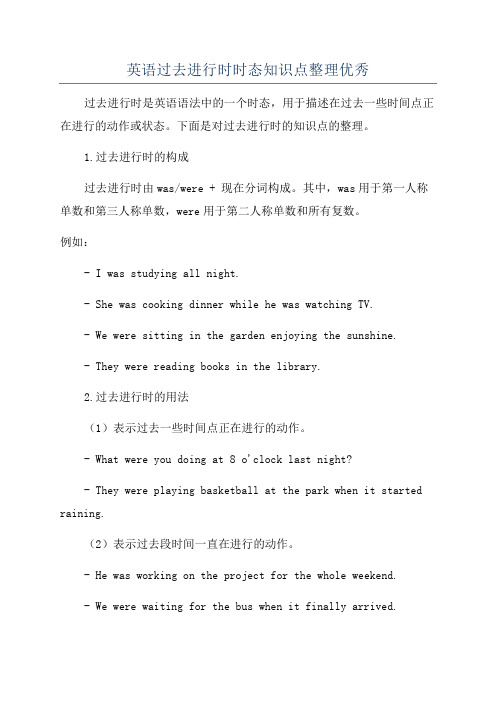
英语过去进行时时态知识点整理优秀过去进行时是英语语法中的一个时态,用于描述在过去一些时间点正在进行的动作或状态。
下面是对过去进行时的知识点的整理。
1.过去进行时的构成过去进行时由was/were + 现在分词构成。
其中,was用于第一人称单数和第三人称单数,were用于第二人称单数和所有复数。
例如:- I was studying all night.- She was cooking dinner while he was watching TV.- We were sitting in the garden enjoying the sunshine.- They were reading books in the library.2.过去进行时的用法(1)表示过去一些时间点正在进行的动作。
- What were you doing at 8 o'clock last night?- They were playing basketball at the park when it started raining.(2)表示过去段时间一直在进行的动作。
- He was working on the project for the whole weekend.- We were waiting for the bus when it finally arrived.(3)表示过去一些时间点由于其他动作的发生而中断的动作。
- I was reading a book when my friend called me.- They were watching a movie when the power went out.(4)与过去一些时间点进行对比,表示过去的同时发生或进展的动作。
- While she was studying, her brother was playing games.- I was walking to work when I saw a car accident.3.过去进行时的否定形式和疑问形式否定形式:在was/were之后加not。
英语过去进行时的定义、结构、用法
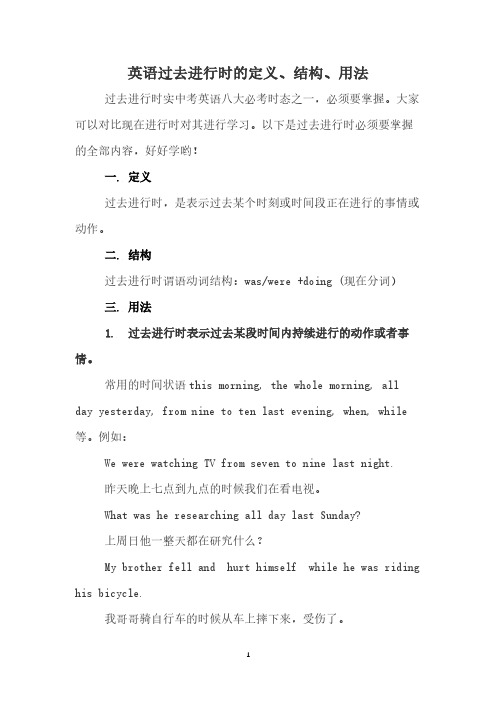
英语过去进行时的定义、结构、用法过去进行时实中考英语八大必考时态之一,必须要掌握。
大家可以对比现在进行时对其进行学习。
以下是过去进行时必须要掌握的全部内容,好好学哟!一. 定义过去进行时,是表示过去某个时刻或时间段正在进行的事情或动作。
二. 结构过去进行时谓语动词结构:was/were +doing (现在分词)三. 用法1. 过去进行时表示过去某段时间内持续进行的动作或者事情。
常用的时间状语this morning, the whole morning, all day yesterday, from nine to ten last evening, when, while 等。
例如:We were watching TV from seven to nine last night.昨天晚上七点到九点的时候我们在看电视。
What was he researching all day last Sunday?上周日他一整天都在研究什么?My brother fell and hurt himself while he was riding his bicycle.我哥哥骑自行车的时候从车上摔下来,受伤了。
It was raining when they left the station.他们离开车站的时候天正在下雨。
When I got to the top of the mountain, the sun was shining.当我到达山顶的时候,阳光灿烂。
2. 过去进行时可以表示在过去某个时间点发生的事情。
时间点可以用介词短语、副词或从句来表示。
例如:What was she doing at nine o'clock yesterday?昨天晚上九点她在做什么? (介词短语表示时间点)She was doing her homework then.那个时候她正在写作业。
(副词表示时间点)When I saw him he was decorating his room.当我看见他的时候他正在装饰房间。
过去进行时 (最完整版)

过去进行时 (最完整版)过去进行时是英语语法中的一种时态,用于表达在过去某个时间正在进行的动作或状态。
在句子中,过去进行时通常由“was/were + 现在分词”构成。
在本文中,我们将详细介绍过去进行时的用法、结构及一些注意事项。
**过去进行时的用法**过去进行时主要用于描述过去某个特定时间点正在进行的动作或状态。
例如:- She was walking in the park when it started to rain.(她在公园里散步时开始下雨。
)- I was studying when the phone rang.(电话响的时候我正在学习。
)过去进行时还可以用于表示两个动作同时进行,其中一个动作是另一个动作的背景。
例如:- While I was cooking dinner, my husband was watching TV.(我正在做晚饭的时候,我丈夫在看电视。
)**过去进行时的结构**过去进行时的结构相对简单,主要是将助动词“was/were”与动词的现在分词形式连用。
具体结构如下:- 主语 + was/were + 现在分词下面是一些例句:- I was reading a book.(我在读一本书。
)- They were talking to each other.(他们在互相交谈。
)**过去进行时的注意事项**1. 过去进行时通常用于“when”、“while”等引导的时间状语从句中,表示一个动作正在进行的过程。
2. 需要注意区分过去进行时和一般过去时的用法,前者表示过去某个时间点正在进行的动作,而后者表示在过去某个时间内发生过的动作。
总而言之,过去进行时是英语语法中一个重要的时态,用于描述过去某个时间点正在进行的动作或状态。
掌握好过去进行时的用法和结构,能够帮助我们更准确地表达过去发生的事情。
希望本文对你有所帮助。
高中英语时态用法:过去进行时和现在完成时

高中英语时态用法:过去进行时和现在完成时高中英语时间是语法,需要学生掌握以理解英语的语法和表达方式。
过去进行时和现在完成时是高中英语中的两个时态,这两个时态虽然使用的时间不同,但是在思维和表达方式上有很多相似之处。
在这篇文章中,我将深入探讨这两个时态的用法和区别。
一、过去进行时过去进行时表示在过去某个时间正在进行的动作或者状态。
它通常有两个或者三个部分。
第一个部分是过去式的“be”动词,第二个部分是动词的现在分词形式,第三个部分是表示时间的状语。
例如:1. I was studying English when my friend called me. (我正在学英语时,我的朋友打电话给我。
)2. The children were playing in the park when it started to rain. (孩子们正在公园里玩耍,这时下起了雨。
)尽管过去进行时的结构看起来很简单,但是正确地使用它需要考虑下列几个要素:1. 过去进行时通常与过去的时间连用,比如“yesterday,”last week,”或者“at that time”。
例如:I was cookin g dinner at 8 o’clock last night. (昨晚8点我在做晚饭。
)2. 过去进行时的肯定形式使用“was/were+现在分词”,而否定形式使用“was/were not+现在分词”。
3. 过去进行时通常用于描述两个同时进行的动作。
比如:I was working on my report while she was watching TV. (我在写报告,她在看电视。
)二、现在完成时现在完成时用于表示前不久发生的动作或者状态跟现在的影响或者结果。
它的基本形式是“have/has+动词的过去分词形式”。
例如:1. I have finished my homework. (我已经完成作业。
)2. She has lived in Canada for five years. (她已经在加拿大生活了五年。
(完整版)过去进行时的用法详解
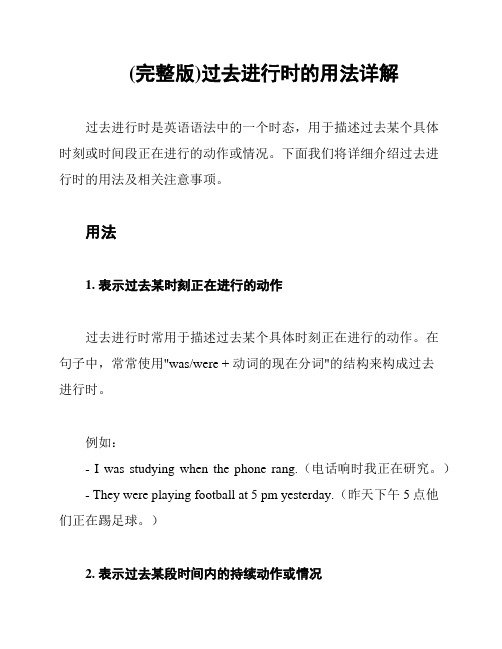
(完整版)过去进行时的用法详解过去进行时是英语语法中的一个时态,用于描述过去某个具体时刻或时间段正在进行的动作或情况。
下面我们将详细介绍过去进行时的用法及相关注意事项。
用法1. 表示过去某时刻正在进行的动作过去进行时常用于描述过去某个具体时刻正在进行的动作。
在句子中,常常使用"was/were + 动词的现在分词"的结构来构成过去进行时。
例如:- I was studying when the phone rang.(电话响时我正在研究。
)- They were playing football at 5 pm yesterday.(昨天下午5点他们正在踢足球。
)2. 表示过去某段时间内的持续动作或情况过去进行时还可以用来描述过去某段时间内的持续动作或情况。
在这种情况下,我们可以使用"was/were + 动词的现在分词"来构成句子。
例如:- She was working hard all day yesterday.(昨天整天她都在努力工作。
)- We were waiting for the bus for two hours.(我们等了两个小时的公交车。
)3. 与过去时态的区别过去进行时与过去时态的区别在于强调动作的持续性,过去进行时更加注重描述过去某个时刻正在进行的动作,而过去时态则着重描述发生在过去的动作或情况。
例如:- I was reading a book when he called.(他打电话时,我正在看书。
)(过去进行时)- I read a book before he called.(他打电话之前,我看了一本书。
)(过去时态)注意事项1. 过去进行时通常与表示过去的时间状语连用,以更准确地表达动作发生的时间点或时间段。
2. 过去进行时不能用于表示经常性的动作或事实,而只适用于特定的过去时刻或时间段。
3. 当过去进行时与其他过去时态同时出现时,我们需要根据语境来确定时间的先后顺序。
动词时态过去进行时

动词时态过去进行时动词时态:过去进行时过去进行时是英语中用来描述在过去某个特定时间段正在进行或发生的动作或状态的一种时态。
它通常以"was/were + 动词-ing"的形式构成,可以用来表示过去某个时间点或时间段内正在进行的动作或状态。
本文将详细探讨过去进行时的用法和示例。
一、过去进行时的用法1. 描述过去某个时间点或时间段正在进行的动作:过去进行时常用于描述过去某个具体时间点进行的动作。
例如: - When I called her, she was cooking dinner. (当我给她打电话时,她正在做晚饭。
)- At 8 o'clock last night, I was watching TV. (昨晚八点,我正在看电视。
)2. 描述过去某个时间段内一直在进行的动作:过去进行时还可以用来描述过去某个时间段内一直在进行的动作。
例如:- I was studying English for three hours yesterday. (昨天我一直在学习英语,持续了三个小时。
)- They were playing basketball all afternoon. (他们整个下午都在打篮球。
)3. 表示过去某个时间点原计划进行的动作被打断:过去进行时还可用于描述原计划正在进行的动作,但在过去某个时间点被其他动作或事件打断了。
例如:- I was studying when the phone rang. (电话响的时候,我正在学习。
)- He was cooking dinner when his friend visited him. (他的朋友来访时,他正在做晚饭。
)二、过去进行时的构成与例句过去进行时的构成很简单,只需在"was/were"后加上动词的-ing形式。
以下是一些例句,展示了过去进行时的用法:1. 正在进行的动作:- She was reading a book last night. (昨晚她正在读书。
九年义务初中英语过去进行时知识点归纳超级精简版

过去进行时指的是过去一些时间点正在进行的动作或状态。
它由助动词“was/were”和动词的现在分词形式构成。
1.构成过去进行时的句子结构:主语 + was/were + 现在分词(动词的ing形式)2.过去进行时的肯定句:主语 + was/were + 动词的ing形式 + 其他成分3.过去进行时的否定句:主语 + was/were + not + 动词的ing形式 + 其他成分4.过去进行时的疑问句:Was/Were + 主语 + 动词的ing形式 + 其他成分?5.过去进行时常用的时间状语:- from 8 to 10 yesterday morning(昨天上午8点到10点)- while I was cooking dinner(当我在做晚饭的时候)6.过去进行时的用法:-表示过去一些时间点正在进行的动作:- She was reading a book when I entered the room.(我进房间时,她正在看书。
)-表示过去一些时间段正在进行的动作:- We were watching a movie from 8 to 10 yesterday evening.(昨天晚上8点到10点我们正在看电影。
)- They were working in the office all day yesterday.(他们昨天一整天都在办公室工作。
)-表示过去一些时间点正在进行的状态:- She was feeling sick yesterday.(她昨天感觉不舒服。
)- The children were sleeping when their parents arrived home.(孩子们在他们父母回家时正在睡觉。
)需要注意的是,过去进行时通常用于过去故事的描写中,它与一般过去时常常同时出现,表示过去一些时间点正在发生的动作或状态。
此外,过去进行时通常和表示具体时间的状语连用,以明确动作发生的时间。
过去进行时知识点讲解
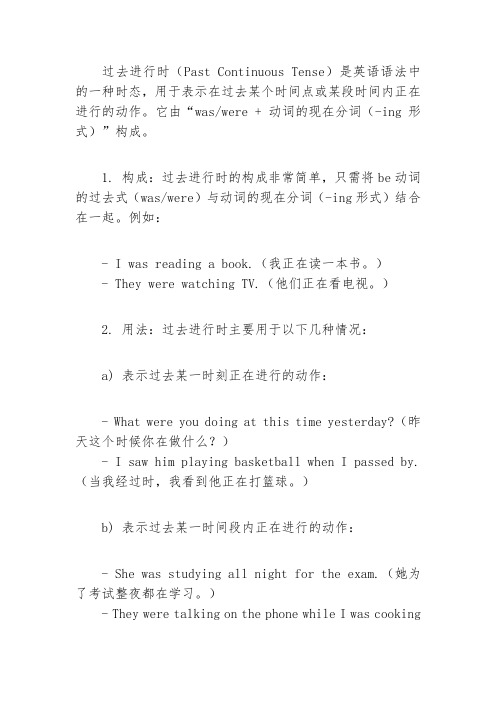
过去进行时(Past Continuous Tense)是英语语法中的一种时态,用于表示在过去某个时间点或某段时间内正在进行的动作。
它由“was/were + 动词的现在分词(-ing形式)”构成。
1. 构成:过去进行时的构成非常简单,只需将be动词的过去式(was/were)与动词的现在分词(-ing形式)结合在一起。
例如:- I was reading a book.(我正在读一本书。
)- They were watching TV.(他们正在看电视。
)2. 用法:过去进行时主要用于以下几种情况:a) 表示过去某一时刻正在进行的动作:- What were you doing at this time yesterday?(昨天这个时候你在做什么?)- I saw him playing basketball when I passed by.(当我经过时,我看到他正在打篮球。
)b) 表示过去某一时间段内正在进行的动作:- She was studying all night for the exam.(她为了考试整夜都在学习。
)- They were talking on the phone while I was cookingdinner.(我在做晚饭的时候,他们在打电话。
)c) 表示过去某一动作发生的背景或同时发生的另一个动作:- He was listening to music while he was working.(他在工作时听音乐。
)- She was reading a magazine when the phone rang.(电话响的时候,她正在看杂志。
)3. 注意事项:a) 当表示过去某一时刻正在进行的动作时,通常与表示过去的时间状语连用,如yesterday, last night, in 1990等。
b) 当表示过去某一时间段内正在进行的动作时,通常与表示过去的时间状语连用,如from 7 to 9 last night, all day yesterday等。
初中英语过去进行时详细讲解
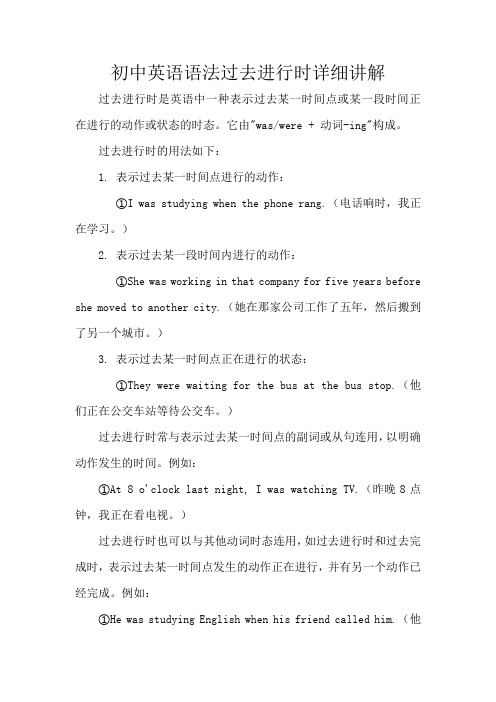
初中英语语法过去进行时详细讲解过去进行时是英语中一种表示过去某一时间点或某一段时间正在进行的动作或状态的时态。
它由"was/were + 动词-ing"构成。
过去进行时的用法如下:
1. 表示过去某一时间点进行的动作:
①I was studying when the phone rang.(电话响时,我正在学习。
)
2. 表示过去某一段时间内进行的动作:
①She was working in that company for five years before she moved to another city.(她在那家公司工作了五年,然后搬到了另一个城市。
)
3. 表示过去某一时间点正在进行的状态:
①They were waiting for the bus at the bus stop.(他们正在公交车站等待公交车。
)
过去进行时常与表示过去某一时间点的副词或从句连用,以明确动作发生的时间。
例如:
①At 8 o'clock last night, I was watching TV.(昨晚8点钟,我正在看电视。
)
过去进行时也可以与其他动词时态连用,如过去进行时和过去完成时,表示过去某一时间点发生的动作正在进行,并有另一个动作已经完成。
例如:
①He was studying English when his friend called him.(他
的朋友给他打电话时,他正在学习英语。
)
需要注意的是,过去进行时并不常用于表示短暂的动作或习惯性的动作。
对于这些情况,一般使用过去简单时。
英语时态:过去进行时
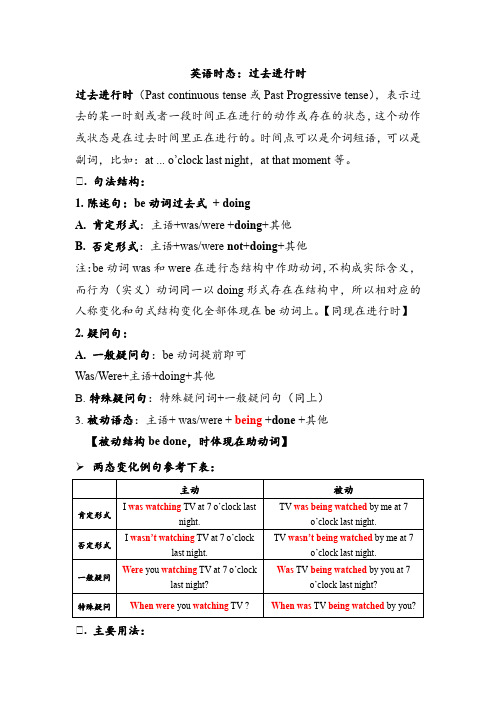
英语时态:过去进行时过去进行时(Past continuous tense或Past Progressive tense),表示过去的某一时刻或者一段时间正在进行的动作或存在的状态,这个动作或状态是在过去时间里正在进行的。
时间点可以是介词短语,可以是副词,比如:at ... o’clock last night,at that moment等。
Ⅰ. 句法结构:1.陈述句:be动词过去式+ doingA. 肯定形式:主语+was/were +doing+其他B. 否定形式:主语+was/were not+doing+其他注:be动词was和were在进行态结构中作助动词,不构成实际含义,而行为(实义)动词同一以doing形式存在在结构中,所以相对应的人称变化和句式结构变化全部体现在be动词上。
【同现在进行时】2.疑问句:A. 一般疑问句:be动词提前即可Was/Were+主语+doing+其他B.特殊疑问句:特殊疑问词+一般疑问句(同上)3.被动语态:主语+ was/were + being +done +其他【被动结构be done,时体现在助动词】➢两态变化例句参考下表:Ⅰ. 主要用法:1.(基本用法)过去进行时主要表示过去某一时间正在进行的动作。
He fell asleep when he was reading.2.用于描写故事情景,或提供故事发生的时间背景。
The fire was burning. Children were crying. Women were running about and men were trying to put it out.3.用过去进行时表示现在,主要是为了使语气委婉、客气。
此类动词主要有hope, wonder, think, expect等。
【一般过去时也有类似用法,但比较而言,用过去进行时显得更客气,更加不肯定。
】I was wondering if you can give me a hand.4.表示从过去某一时间看将要发生的动作,常表示过去“渐渐”、“快要”、“越来越”、“马上”等含义,常见的此类动词有come,go,start,begin,leave,arrive,get,become,turn等非持续性(位置的瞬间移动或状态的瞬间改变)动词,偶尔有些持续性动词如do,stay,take 等常表示过去“将要”。
知识点过去进行时的用法
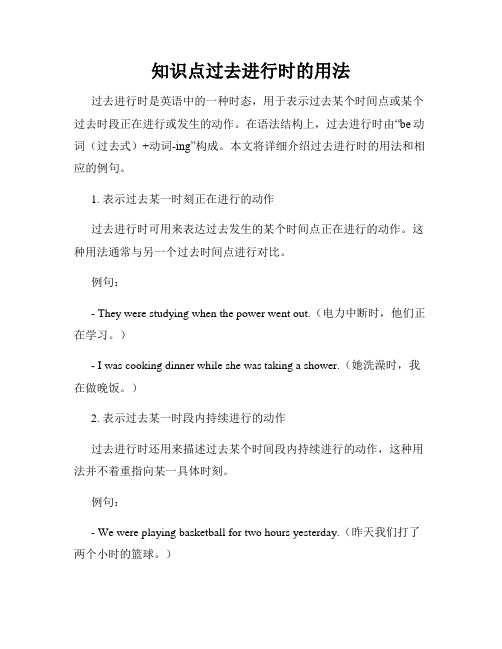
知识点过去进行时的用法过去进行时是英语中的一种时态,用于表示过去某个时间点或某个过去时段正在进行或发生的动作。
在语法结构上,过去进行时由“be动词(过去式)+动词-ing”构成。
本文将详细介绍过去进行时的用法和相应的例句。
1. 表示过去某一时刻正在进行的动作过去进行时可用来表达过去发生的某个时间点正在进行的动作。
这种用法通常与另一个过去时间点进行对比。
例句:- They were studying when the power went out.(电力中断时,他们正在学习。
)- I was cooking dinner while she was taking a shower.(她洗澡时,我在做晚饭。
)2. 表示过去某一时段内持续进行的动作过去进行时还用来描述过去某个时间段内持续进行的动作,这种用法并不着重指向某一具体时刻。
例句:- We were playing basketball for two hours yesterday.(昨天我们打了两个小时的篮球。
)- He was reading a book all evening.(他整晚都在读书。
)3. 表示过去某个时间点的背景动作过去进行时可以用于描述过去的某个时间点,强调其背景下正在进行的动作。
这种用法常常与一般过去时连用,用来提供更完整的背景信息。
例句:- When I arrived at the party, everyone was dancing.(当我到达晚会时,大家都在跳舞。
)- The phone rang while she was having a meeting.(她开会的时候电话响了。
)4. 表示过去愿望和计划过去进行时还可以表达过去的愿望和计划,表示当时的期望或打算。
例句:- I was hoping to visit Paris, but I couldn't afford the trip.(当时我希望能去巴黎,但是支付不起旅费。
过去进行时知识点归纳与总结
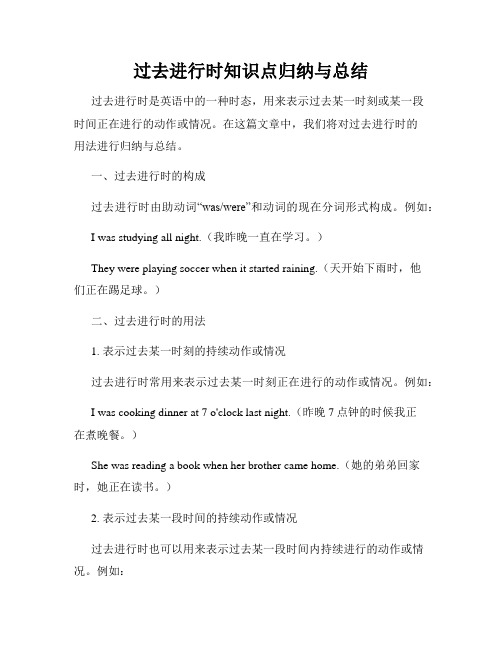
过去进行时知识点归纳与总结过去进行时是英语中的一种时态,用来表示过去某一时刻或某一段时间正在进行的动作或情况。
在这篇文章中,我们将对过去进行时的用法进行归纳与总结。
一、过去进行时的构成过去进行时由助动词“was/were”和动词的现在分词形式构成。
例如:I was studying all night.(我昨晚一直在学习。
)They were playing soccer when it started raining.(天开始下雨时,他们正在踢足球。
)二、过去进行时的用法1. 表示过去某一时刻的持续动作或情况过去进行时常用来表示过去某一时刻正在进行的动作或情况。
例如:I was cooking dinner at 7 o'clock last night.(昨晚7点钟的时候我正在煮晚餐。
)She was reading a book when her brother came home.(她的弟弟回家时,她正在读书。
)2. 表示过去某一段时间的持续动作或情况过去进行时也可以用来表示过去某一段时间内持续进行的动作或情况。
例如:They were living in London for three years.(他们在伦敦住了三年。
)I was working on this project all day yesterday.(我昨天一整天都在做这个项目。
)3. 表示过去某一时刻的计划或安排过去进行时还可以用来表示过去某一时刻的计划或安排。
例如:We were supposed to go to the movies, but it started raining.(我们原本计划去看电影,但天开始下雨了。
)She was going to meet her friends, but she got sick.(她原本打算去见朋友,但她生病了。
)4. 与时间状语连用过去进行时通常与表示过去的时间状语连用,以强调动作或情况的持续性。
高中英语时态用法:过去进行时和现在完成时

高中英语时态用法:过去进行时和现在完成时高中英语时态用法:过去进行时和现在完成时在英语学习中,时态是非常重要的一个内容,有正确地理解和掌握,才能够准确地表达自己的意思并很好地与别人交流。
其中,过去进行时和现在完成时是两个非常常用的英语时态,在学习时需要格外重视。
一、过去进行时过去进行时是用来描述过去某一具体时刻或时间段内正在进行的动作的。
用法:was/were+ 现在分词。
比如:1. I was watching TV when he called me.2. When I was studying, my brother was playing games.3. They were sleeping when I entered the house.过去进行时有时也用来表示两个或多个动作同时发生,此时需要将各个动作的过去进行时连写。
比如:1. She was cooking the dinner while he was setting the table.2. We were playing games and reviewing the book at the same time.二、现在完成时现在完成时是用来描述发生在过去某一时间到现在这段时间内的动作,并强调这段时间内动作对现在造成的影响。
用法:have/has+过去分词。
比如:1. I have eaten lunch.2. She has visited New York twice.3. He has finished the project.现在完成时也可用于描述某一经验、特殊现象或重要成果等,比如:1. I have been to China many times.2. They have learned English for five years.3. We have established a new company.不过,现在完成时有时也容易与过去完成时混淆。
过去进行时 知识点归纳

过去进行时知识点归纳过去进行时是英语语法中的一种时态,用于表示过去某个特定时间正在发生的动作或者状态。
本文将对过去进行时的用法、构成和注意事项进行详细的归纳总结。
过去进行时的构成十分简单,只需将“主语 + was/were + 动词的现在分词”这种形式即可。
例如:They were playing football at this time yesterday.(昨天这个时候他们正在踢足球)过去进行时通常用于描述过去某个特定时间点正在进行的动作,常常与表示时间点的词语或者短语连用,比如at this time yesterday, at 7o'clock last night等等。
例如:I was watching TV when she called me.(她给我打电话的时候,我正在看电视)过去进行时还可以用于表示过去同一时间段内经常反复发生的动作。
例如:He was always talking during class.(他上课的时候总是在说话)需要注意的是,过去进行时有时候也可以表示与过去某个时间点相伴的持续状态。
例如:Last night at 8 o'clock, the children were sleeping soundly in their beds.(昨晚8点,孩子们正在床上安稳地睡觉)在使用过去进行时时,还需要留意一些特殊的情况。
比如在表示感觉动词(如see, hear, taste等)或者状态动词(如be, seem, look等)时,常常不使用进行时态,而是用一般过去时。
例如:I heard a strangenoise when I was walking home last night.(昨晚在我走回家的路上,我听到了一种奇怪的声音)总的来说,过去进行时是表达过去某一时刻正在进行的动作或状态的时态,在英语语法中占有重要的地位。
希望本文能够帮助读者更好地理解和掌握过去进行时的用法和构成。
英语语法 什么是过去进行时
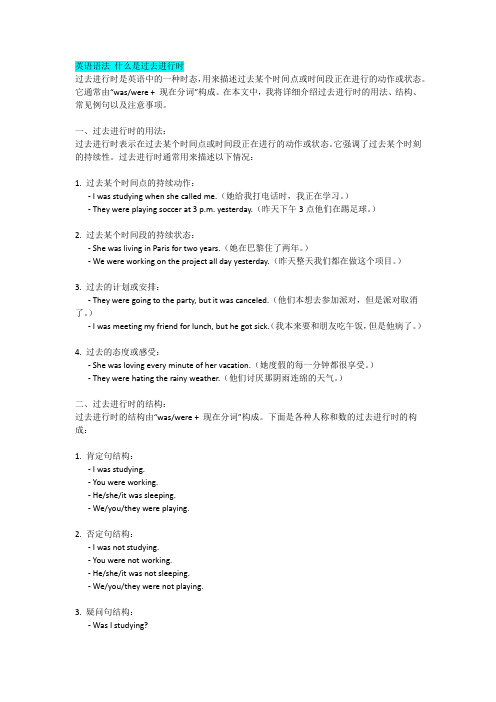
英语语法什么是过去进行时过去进行时是英语中的一种时态,用来描述过去某个时间点或时间段正在进行的动作或状态。
它通常由“was/were + 现在分词”构成。
在本文中,我将详细介绍过去进行时的用法、结构、常见例句以及注意事项。
一、过去进行时的用法:过去进行时表示在过去某个时间点或时间段正在进行的动作或状态。
它强调了过去某个时刻的持续性。
过去进行时通常用来描述以下情况:1. 过去某个时间点的持续动作:- I was studying when she called me.(她给我打电话时,我正在学习。
)- They were playing soccer at 3 p.m. yesterday.(昨天下午3点他们在踢足球。
)2. 过去某个时间段的持续状态:- She was living in Paris for two years.(她在巴黎住了两年。
)- We were working on the project all day yesterday.(昨天整天我们都在做这个项目。
)3. 过去的计划或安排:- They were going to the party, but it was canceled.(他们本想去参加派对,但是派对取消了。
)- I was meeting my friend for lunch, but he got sick.(我本来要和朋友吃午饭,但是他病了。
)4. 过去的态度或感受:- She was loving every minute of her vacation.(她度假的每一分钟都很享受。
)- They were hating the rainy weather.(他们讨厌那阴雨连绵的天气。
)二、过去进行时的结构:过去进行时的结构由“was/were + 现在分词”构成。
下面是各种人称和数的过去进行时的构成:1. 肯定句结构:- I was studying.- You were working.- He/she/it was sleeping.- We/you/they were playing.2. 否定句结构:- I was not studying.- You were not working.- He/she/it was not sleeping.- We/you/they were not playing.3. 疑问句结构:- Was I studying?- Were you working?- Was he/she/it sleeping?- Were we/you/they playing?4. 疑问句的否定回答:- Yes, I was./No, I wasn't.- Yes, you were./No, you weren't.- Yes, he/she/it was./No, he/she/it wasn't.- Yes, we/you/they were./No, we/you/they weren't.三、过去进行时的常见例句:下面是一些常见的过去进行时的例句,以帮助你更好地理解其用法和结构:1. They were watching a movie when I arrived.(我到达时,他们正在看电影。
八年级过去进行时 知识点
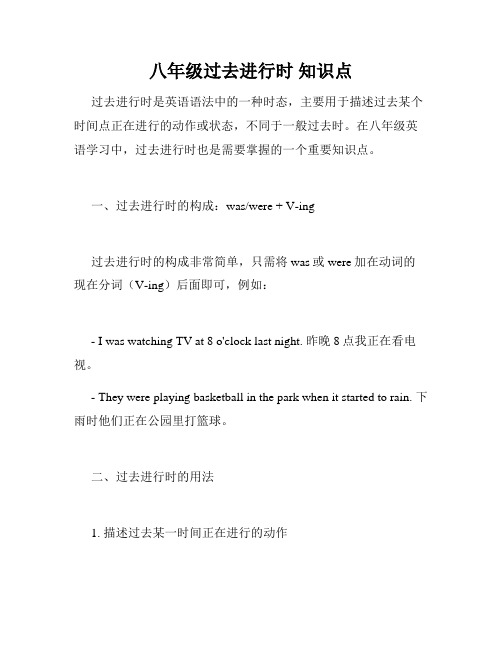
八年级过去进行时知识点过去进行时是英语语法中的一种时态,主要用于描述过去某个时间点正在进行的动作或状态,不同于一般过去时。
在八年级英语学习中,过去进行时也是需要掌握的一个重要知识点。
一、过去进行时的构成:was/were + V-ing过去进行时的构成非常简单,只需将was或were加在动词的现在分词(V-ing)后面即可,例如:- I was watching TV at 8 o'clock last night. 昨晚8点我正在看电视。
- They were playing basketball in the park when it started to rain. 下雨时他们正在公园里打篮球。
二、过去进行时的用法1. 描述过去某一时间正在进行的动作The phone rang while I was having dinner.当我正在吃晚饭时电话响了。
2. 用于加强动作的持续性He was studying for three hours without a break.他连续三个小时都在学习。
3. 描述过去同时发生的两个动作While John was driving to work, he had an accident.约翰在开车上班的路上发生了车祸。
4. 描述过去进行的状态I was feeling tired and hungry after playing basketball all morning.我打了一个上午的篮球后感到又累又饿。
5. 用于表示委婉语气I was just wondering if you could help me with my math homework.我不知道你是否能帮我做数学作业。
三、过去进行时的时间状语表示过去进行时的时间状语有很多种,例如:- at this time yesterday 在昨天这个时间- at 5 o'clock last night 昨晚5点钟- while I was doing my homework 我做作业的时候- at that moment 那个时刻总之,过去进行时是英语语法中非常基础的一个时态,掌握其构成和用法对于八年级的英语学习具有很大的帮助。
浅谈英语时态之五:过去进行时

浅谈英语时态之五:过去进行时过去进行时是英语中一种重要的时态,它能帮助我们表达过去某一时刻或某一时间段内的正在进行或发生的动作。
本文将对过去进行时的构成、用法以及相关注意事项进行详细解析,以帮助大家更好地理解和运用这一时态。
一、过去进行时的构成过去进行时由助动词was/were和现在分词构成。
例如:1.肯定句:We were having supper when the phone rang.(当我们吃晚饭时,电话响了。
)2.否定句:This time yesterday Jack was not watching TV.(昨天这个时候,杰克没有在看电视。
)3.疑问句:Were you playing basketball at four yesterday afternoon?(昨天下午四点你们在打篮球吗?)二、过去进行时的用法1.表示过去某一时刻正在进行的动作:例如:I was reading a book when she came into the room.(当她走进房间时,我正在看书。
)2.表示过去某一时刻正在进行的状态:例如:She was feeling tired after a long day's work.(下班后,她感到很累。
)3.表示过去某一时刻的背景或情境:例如:The sun was setting behind themountains, and the birds were chirping.(太阳落在山后,鸟儿在叽叽喳喳。
)4.表示过去某一时刻计划或安排的事情:例如:We were supposed to go to the park yesterday, but it rained.(昨天我们本来要去公园,但是下雨了。
)5.表示过去某一时刻的反复或持续动作:例如:She was constantly checking her phone during the meeting.(在会议期间,她一直在不停地查看手机。
八年级过去进行时知识点

八年级过去进行时知识点过去进行时是英语语法中的一种时态。
它指过去某个时间段正在进行的动作或者事情,通常会和一个明确的时间段一起出现。
在八年级的英语学习中,了解过去进行时的知识点是必不可少的,下面我将为你详细介绍八年级过去进行时的知识点。
一、过去进行时的基本形式过去进行时是由“was/were + 现在分词”构成的。
其中“was”用于单数主语,“were”用于复数主语,现在分词是动词的-ing形式。
例如:1. I was studying at the library yesterday evening.2. They were playing basketball while I was walking by.二、过去进行时的用法1. 描述过去正在进行的动作或者事件。
例如:- At 7 pm yesterday, I was cooking dinner in the kitchen.- When the phone rang, I was watching TV.2. 描述过去某个时间段期间正在进行的动作或者事件。
例如:- During the summer break, we were practicing our English every day.- At that time, we were living in a small house by the river.3. 突然发生的动作打断了原本正在进行的动作或者事件。
例如:- I was reading a book when my friend knocked on the door.- He was sleeping when the alarm clock went off.4. 常与“while”连用,用于强调同时进行的两个动作或者事件。
例如:- While she was cooking dinner, I was washing the dishes.- While we were walking in the park, we saw a beautiful sunset.三、过去进行时的时间状语时间状语在语法中扮演着重要的角色,它可以用来说明动作发生的时间、持续的时间、频率等。
(完整版)过去进行时的结构

(完整版)过去进行时的结构过去进行时的结构 (完整版)过去进行时是英语中表示过去某个时间正在发生的动作或事件的一种时态。
它由"was/were + v-ing"的结构构成。
本文将介绍过去进行时的结构,并提供一些例句以帮助理解。
结构过去进行时的结构非常简单,只需要用"was"或"were"和动词的-ing形式来构成。
具体结构如下:- 肯定句: 主语 + was/were + 动词的-ing形式- 否定句: 主语 + was not/were not + 动词的-ing形式- 疑问句: Was/Were + 主语 + 动词的-ing形式用法过去进行时主要用于描述过去某个特定时间正在进行的动作或事件。
它可以用于以下情况:1. 过去某个具体时间的持续动作:Tom was studying at 8 p.m. yesterday.(昨天晚上8点钟汤姆正在研究。
)2. 过去发生的连续动作:They were laughing and talking during the party.(他们在聚会期间一直在笑和谈话。
)3. 过去两个同时进行的动作:While Lisa was cooking dinner, Mark was cleaning the living room.(当丽莎在做晚餐时,马克在打扫客厅。
)4. 过去的计划或意图:I was going to the cinema, but it started raining.(我原本打算去电影院,但突然下雨了。
)注意事项1. 过去进行时强调过去某一点时间的动作或事件,因此通常需要配合具体的时间状语,以清晰表达动作发生的时间点或时间段。
2. 过去进行时与过去简单时一起使用,可以完整地描述过去的动作。
3. 过去进行时通常不能用于描述长时间的惯或状态,而是用于表示一个具体的动作或事件。
以上就是过去进行时的基本结构和用法。
- 1、下载文档前请自行甄别文档内容的完整性,平台不提供额外的编辑、内容补充、找答案等附加服务。
- 2、"仅部分预览"的文档,不可在线预览部分如存在完整性等问题,可反馈申请退款(可完整预览的文档不适用该条件!)。
- 3、如文档侵犯您的权益,请联系客服反馈,我们会尽快为您处理(人工客服工作时间:9:00-18:30)。
英语时态之过去进行时过去进行时过去进行时表示在过去某一时刻或某一段时间进行或发生的动作。
其形式为was /were + V-ing。
常与表示过去的时间状语连用,如:last night, last Saturday等;或者与when, while, as引导的过去时间状语连用。
概念过去进行时(Past continuous tense或Past Progressive tense)表示过去某时正在进行过去进行时的动作(不强调是否完成)。
(过去进行时具体用在什么地,看下面的容)结构1. 过去进行时由“主语+was/were + 现在分词”构成EX:We were having supper when the phone rang. 我们正在吃晚饭时响了。
2. 过去进行时的否定式由“主语+was/were not +现在分词”构成EX:This time yesterday Jack was not watching TV. He was repairing his bike. 昨天这个时候,杰克不是在看电视,而是在修理自行车。
3. 过去进行时的疑问式由“was/were +主语+ 现在分词”构成EX:Were you playing basketball at four yesterday afternoon? 昨天下午四点你们在打篮球吗?主要用法基本用法1. 过去进行时的基本用法主要表示过去某一时间正在进行的动作。
过去进行时如:He fell asleep when he was reading. 他看书时睡着了。
2. 用过去进行时表示现在主要是为了使语气委婉、客气。
如:I was wondering if you could give me a lift. 我不知你能否让我搭一下车。
【注】一般过去时也有类似用法,但比较而言,用过去进行时显得更客气,更不肯定。
3. 过去进行时表示感情色彩与现在进行时相似,过去进行时也可表示满意、称赞、惊讶、厌恶等感情色彩,也通常与always,forever,continually等副词连用。
如:They were always quarrelling. 他们老是吵架。
4. 动词be的过去进行时也可表示过去一时的表现或暂时的状态。
比较:He was friendly. 他很友好。
(指过去长期如此)He was being friendly. 他当时显得很友好。
(指当时一时的表现)补充:when 的后面加一般过去时,而且动词是不延续性动词。
while 的后面加过去进行时,动词是延续性动词。
特殊用法1、当句子意思很清楚时,我们也可以把两个动词都换成一般过去时We listened carefully when the teacher read the text. 老师读课文时,我们都仔细地听着。
2、表示按计划、安排过去将要发生的事。
用于come,go,leave,start,arrive等表示位置转移的动词时,也可以用过去进行时表示过去将要发生的动作。
如:He told me that he was going soon. 他告诉我他很快就要走了。
3、表示故事发生的背景。
It was snowing as the medical team made its way to the front. 那支医疗小组往前线行进时,天正下着雪。
4、表示一个新的动作刚刚开始。
过去进行时可用来引出一个新的动作,这种用法颇有点儿像镜头转换。
Five minutes later,he stood in the doorway smoking a cigarette. 5分钟后,他已站在门口抽着烟。
5、过去进行时还可和when结构遥相呼应,含有意外之意。
I was walking in the street when someone called me. 我正在街上走时突然有人喊我。
6、用来述原因或用作借口。
She went to the doctor yesterday. She was having a lot of trouble with her heart.她昨天去看病了。
她患了很重的心脏病。
7、与always,constantly等词连用,表示感情色彩。
The girl was always changing her mind. 这女孩老是改变主意。
变化规则现在分词1. 在动词原形后直接加-inglook-looking cook-cooking read-reading2. 以不发音字母e结尾的动词,去掉e再加-ingwrite-writing live-living3. 以重读闭音节结尾且末尾只有一个辅音字母的动词,双写该辅音字母后再加-ingbegin-beginning swim-swimming sit-sitting4. 少数几个以ie结尾的动词,要变ie为y,再加-ingtie-tying die-dying lie-lying常用的时间状语this morning,the whole morning,all day,yesterday,from nine to ten last evening,when,while,at that time.My brother fell while he was riding his bicycle and hurt himself;It was raining when they left the station;When I got to the top of the mountain,the sun was shining.典型例题(1)Mary _C_ a dress when she cut her finger.A. madeB. is makingC. was makingD. makes答案C. 割伤手指是已发生的事情,应用过去时。
同时,when表时间的同时性,"玛丽在做衣服时"提供事情发生的背景,因此用过去进行时。
(2)As she _b_ the newspaper,Granny _b_ asleep.A.read;was fallingB. was reading;fellC. was reading;was fallingD. read;fell答案B. 句中的as = when,while,意为"当……之时"。
描述一件事发生的背景时,用过去进行;一个长动作发生的时候,另一个短动作发生。
句意为"在她看报纸时,奶奶睡着了。
"句中的fell (fall的过去时),是系动词,后跟形容词,如:fall sick。
过去进行时的基本用法:表示过去某个时刻或时间正在进行过持续进行的动作,句中往往需要有时间状语来表示这一特定的时间. What were they doing just now? 他们刚才在干什么?具体概念一、概念和用法:过去进行时表示在过去某一时刻或某一段时间进行或发生的动作。
其形式为was /were + V-ing。
常与表示过去的时间状语连用,如:last night,last Saturday等;或者与when,while,as引导的过去时间状语连用。
例如:We were watching TV from seven to nine last night. 昨天晚上七点到九点的时候我们在看电视。
What was he researching all day last Sunday? 上日他一整天都在研究什么?二、过去进行时可以表示在过去某个时间点发生的事情。
时间点可以用介词短语、副词或从句来表示。
如:What was she doing at nine o‘clock yesterday? 昨天晚上九点她在做什么?(介词短语表示时间点)When I saw him he was decorating his room. 当我看见他的时候他正在装饰房间。
(when从句表示时间点)三、在复合句中,如果主要动作和背景动作都是延续的或同时发生的,那么主从句的动词都可用过去进行时。
例如:While he was waiting for the bus,hewas reading a newspaper.他边等车边看报。
(两个动作都是延续的)He was cleaning his car while I was cooking. 他擦车时我在做饭。
(两个动作同时进行)四、通常不能用于过去进行时的动词主要有:agree,is,am,are,believe,belong,care,forget,hate,have(拥有),hear,know,like,love,mean,mind,notice,own,remember,seem,suppose,understand, want,wish等。
例如:误:I was knowing the answer.正:I knew the answer. 我知道答案。
误:I wasn‘t understanding him.正:I didn‘t understand him. 我不明白他的意思。
句型肯定句=主语(I/you/he/she/It/they/we)+was/were+doing+其它否定句=主语(I/you/he/she/It/they/we)+was/were+not+doing+其它一般疑问句及答语=Was/Were+主语(You/he/she/they/we)+doing+其它答语:Yes,I was./No,I wasn't.特殊疑问句=特殊疑问词+was/were+主语(I/you/he/she/they/we)+doing+其它时态比较过去进行时与一般过去时都强调过去发生的事进行时强调过程,不一定完成过去时强调事件,一定完成p.s.:表示一个动作正在进行时,另一个动作发生了如:He played when I was studying.过去进行时与一般过去时,两者都表示过去发生的动作,但过去进行时表示在过去某一特定的时间点或时间段正在进行的动作,而一般过去时表示在过去时间完成的动作。
例如:I was typing a letter last night. 昨晚我在打一封信.(可能没打完)I typed some letters last night. 我昨晚打了一些信.(已经打完)1、一般过去时往往表示某一动作已经完成,而过去进行时却表示动作在持续或未完成。
(延续性动词)She wrote a letter to her friend last night. 她昨晚给朋友写了封信。
